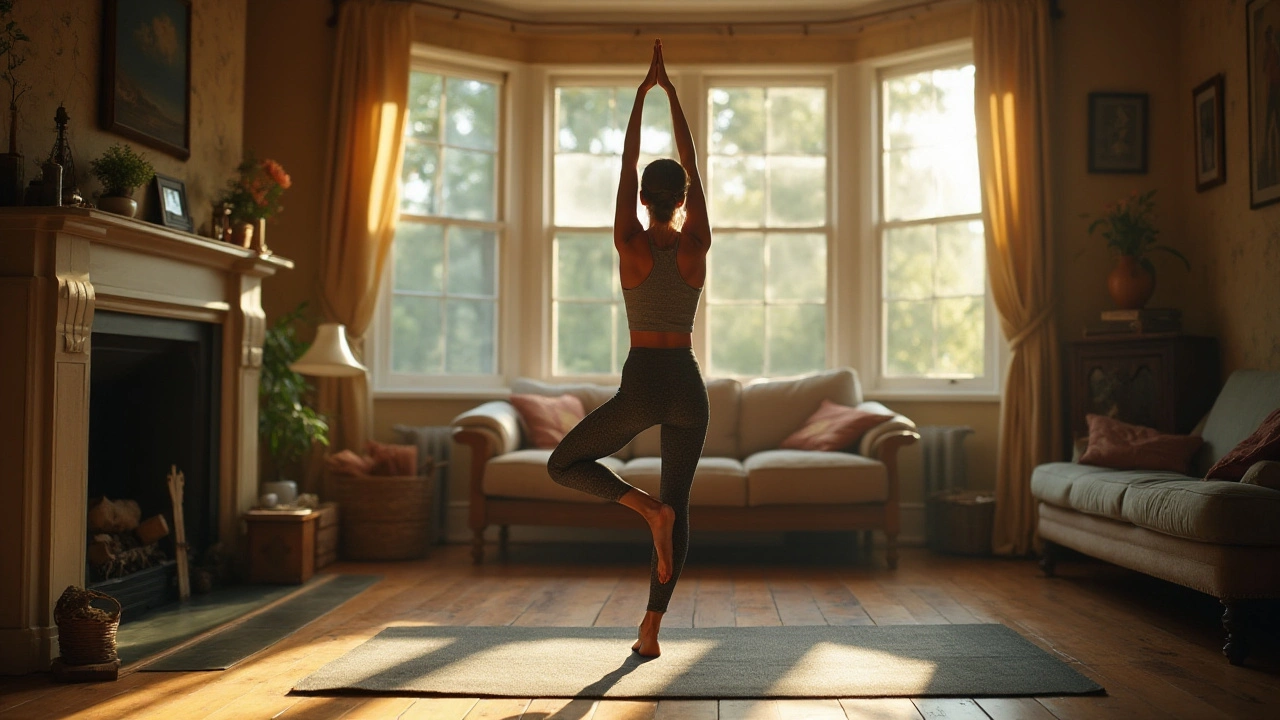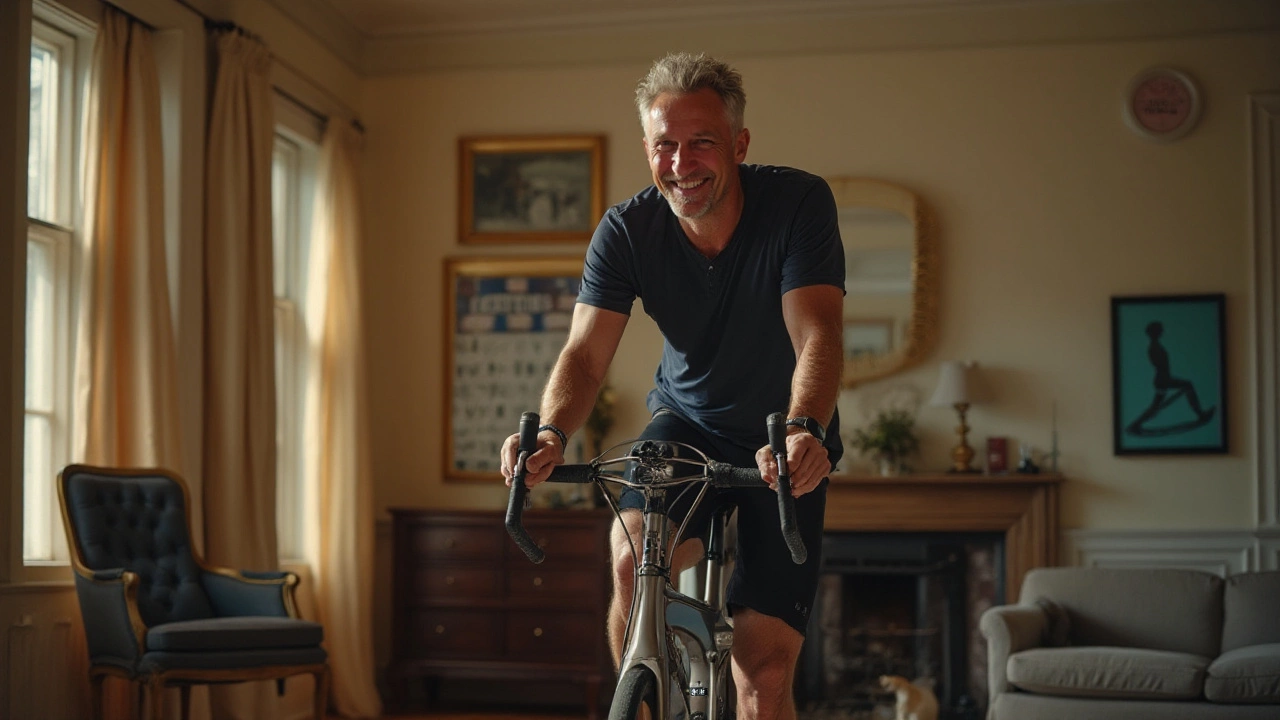
In the hustle and bustle of modern life, carving out time for exercise can seem daunting. Yet, there’s a growing chorus of fitness experts who swear by the effectiveness of a mere 30-minute workout done in the comfort of your own home. But does less really mean more when it comes to shedding those stubborn pounds?
With endless responsibilities pulling us from every direction, a short and sweet fitness routine might just be the practical solution we need. This article delves into the reasons why a half-hour workout might be enough, focusing not only on the scale but also on broader aspects of health and well-being. We'll explore the science backing short workouts, highlight some powerful exercises that fit into half an hour, and share tips to ensure you're getting the most out of your time.
Ready to transform your living room into your personal gym and potentially revolutionize your fitness journey? Let's uncover the potential that lies in a 30-minute commitment.
- The Science Behind Short Workouts
- Consistency Over Duration
- Effective Home Exercises
- Maximizing Your 30-Minute Routine
The Science Behind Short Workouts
There’s a buzz around the concept of fitting an efficient workout into a short time frame, and it's not without substance. Recent studies illuminate how short, intense workouts can be just as rewarding, if not more so, than longer sessions. The key lies in what's known as High-Intensity Interval Training (HIIT). This approach, characterized by short bursts of intense effort followed by rest, has proven to not only boost cardiovascular fitness but also improve metabolism, making it an ideal method for weight loss.
Interestingly, researchers have found that HIIT can significantly enhance your body’s ability to burn fat long after the workout is over, a phenomenon known as 'afterburn'. The science behind this is that your body continues to consume oxygen at an elevated rate post-exercise, which translates into continued calorie burning for hours. It's a metabolic gift that keeps on giving. Some studies even suggest that just 15 minutes of HIIT can yield adaptations in skeletal muscle, contributing to increased fat oxidation, a key element in effective weight loss.
"The best workout is the one you actually do," a mantra popularized by fitness expert Dr. John Ratey, underscores the idea that consistency and dedication often matter more than duration.
Yet, it’s not just about burning fat. Short workouts also provide a mental boost that's pivotal in our hectic lives. When pressed for time, the struggle to engage in regular exercise can often end in frustration and feelings of inadequacy. However, knowing that dedicating even 30 minutes a day can make a meaningful impact is incredibly empowering. This approach supports not only physical well-being but also mental health, enhancing mood and reducing stress through the release of endorphins.
It's worth noting that shorter workouts can also have a positive impact on maintaining muscle mass, which is crucial as it directly influences your basal metabolic rate—the number of calories your body needs to function at rest. Carefully curated routines that include resistance training can help in maintaining, if not increasing, muscle mass, while also shedding fat. Plus, incorporating diverse exercises keeps the routine enjoyable and prevent plateaus by continually challenging the body.
How Short Workouts Optimize Time
When it comes to using time wisely, short workouts stand tall. Often packaged as circuit training or bodyweight exercises, they're designed to target multiple muscle groups efficiently. This variety keeps each session fresh and exciting. For example, a typical circuit might include exercises like push-ups, squats, and lunges. Each movement is performed for a set period, say, 30 seconds, with minimal rest between sets. This format ensures a full-body workout, utilizing every minute judiciously. Additionally, the compact nature makes them easy to fit into daily schedules, even the busiest ones.
Let's look at some interesting data that highlights the efficacy of short workouts. Based on a survey conducted by the American College of Sports Medicine, 27% of individuals reported better mood and increased energy after engaging in a short, structured exercise regimen. What's more encouraging is that 32% noted consistent weight loss results over a six-month span, aligning closely with those who performed longer exercise sessions.
The beauty of these sessions lies in their adaptability. Whether you’re at home or traveling, there’s always an opportunity to squeeze in that much-needed activity. And with the plethora of online resources available, from guided video sessions to fitness apps, tailoring a home workout experience to your personal goals has never been easier.

Consistency Over Duration
When it comes to effective weight loss through exercise, consistency often trumps duration. Many people get caught up in how long they work out, but research indicates it's the regularity of exercise that truly leads to sustainable results. A regular 30-minute workout done most days of the week can be more beneficial than sporadic longer sessions. Keeping it consistent helps in forming a habit, and once exercise becomes a part of your routine, it seamlessly integrates into your life. The human body thrives on regularity, adapting more efficiently to set, predictable routines, which in turn optimizes calorie-burning processes and muscle toning over time.
The power of consistency lies in its ability to create positive feedback loops. When you engage in regular physical activity, like a daily 30-minute session, you’re more likely to see and feel the benefits. This can lead to increased motivation and a reinforced commitment to keeping at it. Some experts suggest setting a scheduled time each day just as you would for a work meeting or a coffee date. A routine not only increases adherence but provides a mental framework to track progress and make adjustments as necessary. When exercise becomes habitual, it significantly boosts your commitment, driving better long-term results for weight loss.
"Success doesn’t come from what you do occasionally, it comes from what you do consistently," says the renowned fitness guru, Marie Forleo. Her words highlight the importance of regular effort over occasional bursts of activity.
Consistency also plays a crucial role in maintaining a balanced lifestyle, incorporating both physical and psychological well-being. Regular exercise contributes to managing stress levels, improving mood, and sleeping better, all of which are crucial aspects of holistic health. By sticking to a daily routine, you're planting the seeds for these broader benefits, which, while not directly measurable on a scale, have profound impacts. The regularity allows your body to manage and regulate hormones better, which can be a key driver in supporting weight loss, particularly as part of a comprehensive lifestyle approach.
Consider this: consistency in home workout routines also trains your brain. With repeated sessions, cognitive pathways associated with exercise motivation and adherence get strengthened. Soon, activities that once felt like a chore become enjoyable, or even necessary, parts of your day. Additionally, home workouts provide the unique advantage of removing barriers to exercise such as travel time, gym fees, and self-consciousness that can come from exercising in public spaces. You can design a personalized regime that fits seamlessly into your lifestyle, making it easier to remain consistent.
It's also worth noting that the consistency factor can be quantified to some extent. According to a recent study published in the “Journal of Sports Sciences,” individuals who exercise consistently for just half an hour see significant benefits over their sedentary counterparts, even if their sessions aren’t high intensity. Their study found that heart health markers, mood improvements, and metabolic benefits all show statistically significant improvements, underscoring the principle of steady effort over periodic marathons.

Effective Home Exercises
When it comes to shedding those extra pounds with a home workout, the type of exercises you choose can make all the difference. It’s not just about moving your body, but about moving it in ways that burn calories, build muscle, and enhance your overall fitness. Many exercises can be done without any equipment, although having some basic gear like dumbbells or resistance bands can add to the intensity and variety of your routine.
Bodyweight exercises are particularly effective in a 30-minute workout because they require no equipment and can be easily modified to increase difficulty as you become stronger. Squats are a classic example. By engaging multiple muscle groups, including the thighs, hips, and buttocks, squats help in building muscle which in turn enhances metabolism. Other than that, think about lunges, which not only work on similar areas but also improve balance and coordination.
"Incorporating strength-building exercises like push-ups and planks into your routine can significantly boost your metabolism," says Ava Johansen, a renowned fitness expert. "These exercises are fantastic for developing core strength and promoting lean muscle growth."
Cardiovascular exercises are another critical aspect to consider. Jumping jacks, high knees, and burpees can elevate heart rate quickly, leading to calorie burn. For those looking to build their endurance and cardiovascular fitness, these exercises form the cornerstone of any effective home workout. It’s crucial to maintain good form and stay mindful of your body's signals to avoid injury.
For those with a small investment, resistance bands are an exceptional tool to add to your home fitness arsenal. They are lightweight, cost-effective, and can increase the effectiveness of exercises like chest pulls and deadlifts, simulating the resistance you’d find with heavier weights in a gym setting. They are particularly useful for rehabilitating muscles too, so if you're bouncing back from an injury, these might be a gentle yet effective solution.
| Exercise | Main Benefit |
|---|---|
| Squats | Strengthens legs and core |
| Push-ups | Builds upper body strength |
| Planks | Enhances core stability |
| Jumping Jacks | Boosts cardiovascular fitness |
| Burpees | Full body workout |
Stretching should not be underestimated either. Including a variety of stretches post-workout can improve flexibility, reduce muscle soreness, and aid in recovery. Gentle yoga sequences or targeted stretches can complement your workout regime, ensuring your efforts are balanced between strength, cardio, and flexibility.

Maximizing Your 30-Minute Routine
So you've committed to a 30-minute home workout to achieve your weight loss goals. But how can you ensure those precious minutes are used effectively? The key lies in planning and variety; keeping your body guessing prevents plateaus that often halt progress. Structure each session into small segments dedicated to different activities, such as cardio, strength, and flexibility. This balanced approach not only aids in shedding pounds but also improves overall physical fitness. Begin with a five-minute warm-up to prepare your body for more vigorous exertion, raising your heart rate and getting blood flowing to the muscles.
Engage in compound exercises—those that work multiple muscle groups at once—to maximize calorie burn. Consider movements like squats with overhead presses or lunges with bicep curls. Not only do these exercises increase efficiency, but they also enhance muscle strength and endurance, crucial components for sustained weight loss. Cardio intervals are another effective inclusion, alternating between high-intensity movements, like jumping jacks or burpees, and lower-intensity recovery stages. By integrating these dynamic exercises, your routine keeps energy costs high, which can lead to effective weight reduction.
Strength training is pivotal, even in a quick workout. Muscle maintenance and growth enhance metabolism, which naturally aids in managing body weight. Incorporate bodyweight exercises such as push-ups or planks, or use resistance bands for added intensity. Vary your selections regularly to continually challenge your muscles and prevent adaptation. Including short periods of active recovery—not rest—between sets may also contribute to this balanced routine, ensuring effectiveness in that short timeframe.
Nourishment, both physical and mental, enriches your fitness journey. Reduce stress by focusing on the quality of each movement rather than sheer number. Often, when we rush through reps, we sacrifice form, which can lead to injury. Allow yourself to be present with each exercise—a mindful approach promotes deeper connection with your body and enhances motivation. Additionally, tracking your progress with a fitness journal or app can offer insights into what's working well and what needs adjustment.
The consistency of your workout schedule is vital. The magic of a 30-minute burst is its sustainability; it's more important to maintain frequent sessions than to push yourself through an exhaustive one-hour routine you can't keep up with. Reflect on this encouraging thought from Dr. Sarah Hallberg, "Staying active is a lifelong investment in health, fulfilling in ways beyond the physical." This reiterates that while the workout may be brief, the benefits ripple through many aspects of life.
"Intensity trumps duration, especially when you practice consistently," reminds James Clear, author of Atomic Habits. "It's not about doing the maximum today, but about doing something regularly over time."
